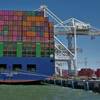Just when the cruise industry thought that the nasty little Norwalk Virus bug – a gastrointestinal virus that strikes quickly with symptoms that cause much discomfort. While there is no cure for this rapid-spreading virus that is usually spread through food, but can be picked from germs spread via handrails or elevator buttons, the ordeal usually lasts anywhere from 24-48 hours.
he virus first made its entrance late last year and was not exclusive to just one cruise line. Some of cruise’s biggest players such as P&O, Holland America, Carnival and Disney all reported sporadic cases of the virus onboard its vessels at several ports.
This time however, the virus is back from what the industry thought was hopefully its permanent holiday, as Regal Princess was forced to skip its last two ports of call on its itinerary – Qaqortog, Greenland and St. Johns, Newfoundland – arriving one day early to its homeport in NY Harbor.
A
ccording to a statement issued by Princess Cruises, the vessel left for Copenhagen on August 18, 2003 for a 16-day excursion in Northern Europe/Atlantic crossing, returning to New York on September 2, 2003. Of the 1,528 passengers and 679 crew who were aboard Regal Princess, Princess concedes that 296 passengers and 44 crew became stricken with the virus.
It has been suggested, as per the statement, that the pattern of the virus’ spreading most likely commenced on the ship in Copenhagen by a passenger who picked it up there. At the onset of the virus, which occurred three days into the vessel’s journey, Princess went into action by upgrading its sanitation efforts so that transmission would be quarantined to some extent onboard Regal Princess.
Working together with local and international public health agencies, Princess commenced an extensive sanitation program onboard the vessel in conjunction with the U.S. Centers for Disease Control (CDC), U.K. Port Health Authorities and Health Canada, in order to halt the spread of the virus.
Princess reports that through these efforts to constrain the virus have proved fruitful as the line saw the incidences of stricken passengers decline, as well as the ill recovering within as soon as 12-24 hours.
Featured videos

Unlock Onboard Data Efficiencies

Tracking Foreign Vessels Working in the U.S. Jones Act Market

Inmarsat Enhances Service to Drive Digitalization
Subscribe for
Maritime Reporter E-News
Maritime Reporter E-News is the maritime industry's largest circulation and most authoritative ENews Service, delivered to your Email five times per week









